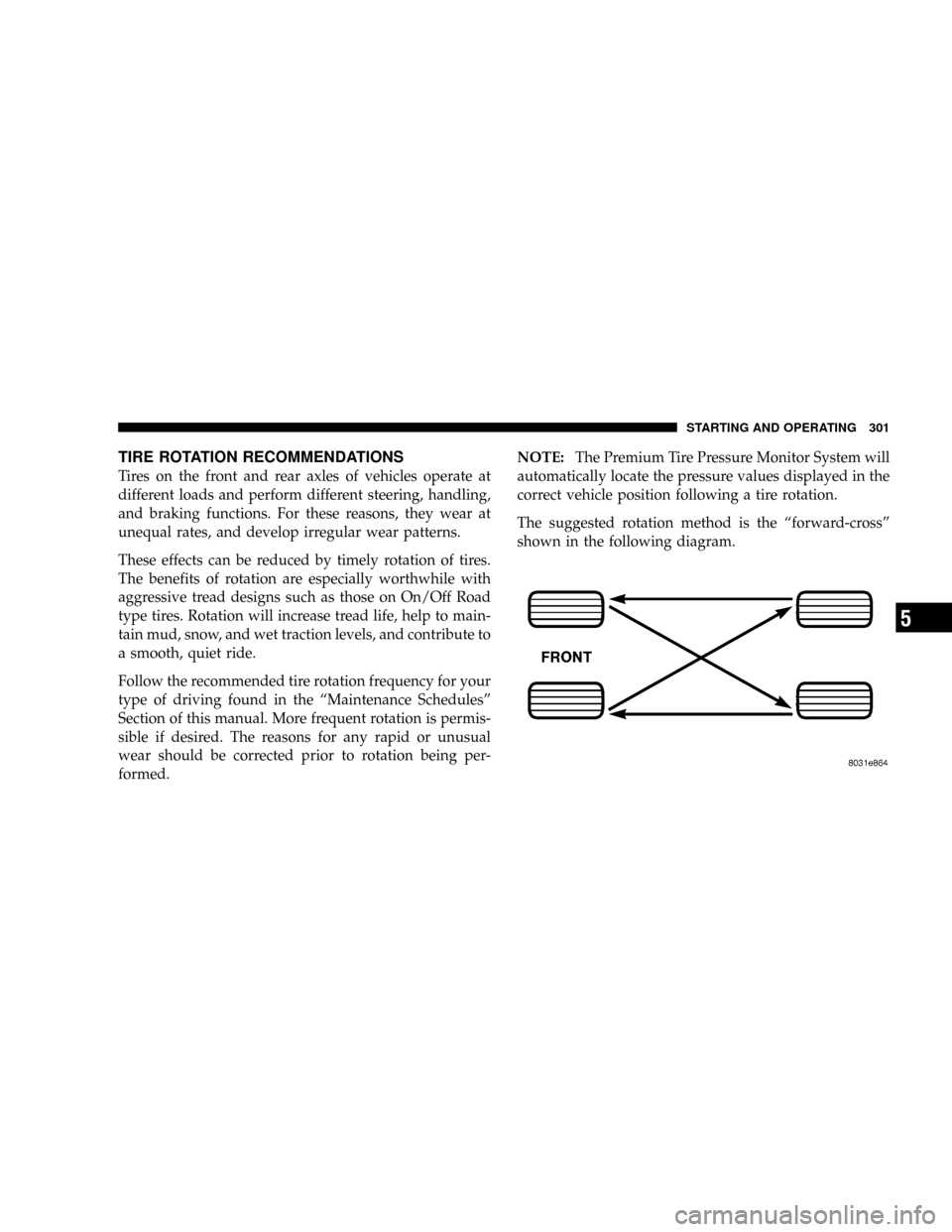Page 301 of 448

TIRE ROTATION RECOMMENDATIONS
Tires on the front and rear axles of vehicles operate at
different loads and perform different steering, handling,
and braking functions. For these reasons, they wear at
unequal rates, and develop irregular wear patterns.
These effects can be reduced by timely rotation of tires.
The benefits of rotation are especially worthwhile with
aggressive tread designs such as those on On/Off Road
type tires. Rotation will increase tread life, help to main-
tain mud, snow, and wet traction levels, and contribute to
a smooth, quiet ride.
Follow the recommended tire rotation frequency for your
type of driving found in the“Maintenance Schedules”
Section of this manual. More frequent rotation is permis-
sible if desired. The reasons for any rapid or unusual
wear should be corrected prior to rotation being per-
formed.NOTE:The Premium Tire Pressure Monitor System will
automatically locate the pressure values displayed in the
correct vehicle position following a tire rotation.
The suggested rotation method is the“forward-cross”
shown in the following diagram.
STARTING AND OPERATING 301
5
Page 316 of 448

2. GTW
3. GAWR
4. Tongue weight rating for the trailer hitch utilized
(This requirement may limit the ability to always
achieve the 10% to 15% range of tongue weight as a
percentage of total trailer weight).
Towing Requirements—Tires
�
Do not attempt to tow a trailer while using a compact
spare tire.
�Proper tire inflation pressures are essential to the safe
and satisfactory operation of your vehicle. Refer to the
Ti re s–General Information section of this manual on
Tire Pressures for proper tire inflation procedures.
�Also, check the trailer tires for proper tire inflation
pressures before trailer usage.
�Check for signs of tire wear or visible tire damage
before towing a trailer. Refer to the Tires–General
Information section of this manual on Tread Wear
Indicators for the proper inspection procedure.
�When replacing tires refer to the Tires–General Infor-
mation section of this manual on Replacement Tires for
proper tire replacement procedures. Replacing tires
with a higher load carrying capacity will not increase
the vehicle’s GVWR and GAWR limits.
Towing Requirements—Trailer Brakes
�
Donotinterconnect the hydraulic brake system or
vacuum system of your vehicle with that of the trailer.
This could cause inadequate braking and possible
personal injury.
316 STARTING AND OPERATING
Page 364 of 448

Cooling System
WARNING!
You or others can be badly burned by hot antifreeze/
coolant or steam from your radiator. If you see or
hear steam coming from under the hood, don’t open
the hood until the radiator has had time to cool.
Never try to open a cooling system pressure cap
when the radiator or coolant bottle is hot.
Engine Coolant Checks
Check antifreeze/coolant protection every 12 months
(before the onset of freezing weather, where applicable).
If antifreeze/coolant is dirty or rusty in appearance, the
system should be drained, flushed and refilled with fresh
antifreeze/coolant. Check the front of the A/C condenserfor any accumulation of bugs, leaves, etc. If dirty, clean by
gently spraying water from a garden hose vertically
down the face of the condenser.
Check the engine cooling system hoses for brittle rubber,
cracking, tears, cuts, and tightness of the connection at
the coolant recovery bottle and radiator. Inspect the
entire system for leaks.
With the engine at normal operating temperature (but
not running), check the cooling system pressure cap for
proper vacuum sealing by draining a small amount of
coolant from the radiator drain cock. If the cap is sealing
properly, the antifreeze/coolant will begin to drain from
the coolant recovery bottle. DO NOT REMOVE THE
COOLANT PRESSURE CAP WHEN THE COOLING
SYSTEM IS HOT.
364 MAINTAINING YOUR VEHICLE
Page 398 of 448
•Check the windshield washer solvent, add as required.
Once a Month
•Check the tire pressure and look for unusual wear or
damage.
•Inspect the battery and clean and tighten the terminals
as required.
•Check the fluid levels of the coolant reservoir, brake
master cylinder, and transmission, and add as needed.
•Check all lights and all other electrical items for correct
operation.At Each Oil Change
•Change the engine oil filter.
•Inspect the exhaust system.
•Inspect brake hoses.
•Check the engine coolant/anti-freeze level, hoses, and
clamps.
•After completion of off-road operation, the underside
of the vehicle should be thoroughly inspected. Exam-
ine threaded fasteners for looseness.
398 MAINTENANCE SCHEDULES
8
M
A
I
N
T
E
N
A
N
C
E
S
C
H
E
D
U
L
E
S
Page 400 of 448
Miles 3,000 6,000 9,000 12,000 15,000
(Kilometers) (5 000) (10 000) (15 000) (20 000) (25 000)
Change the engine oil and engine oil filter, if not
replaced at 3 months.X X XXX
Rotate the tires. X X
Check spare tire for proper pressure and correct
stowage.XX
Inspect the engine air cleaner filter, replace if nec-
essary.X
Drain and refill the front and rear axles. X
Inspect the brake linings. X
400 SCHEDULE“B”
8
M
A
I
N
T
E
N
A
N
C
E
S
C
H
E
D
U
L
E
S
Page 401 of 448
Miles 18,000 21,000 24,000 27,000 30,000
(Kilometers) (30 000) (35 000) (40 000) (45 000) (50 000)
Change the engine oil and engine oil filter, if not
replaced at 3 months.X X XXX
Rotate the tires. X X X
Check spare tire for proper pressure and correct
stowage.XXX
Inspect the engine air cleaner filter, replace if nec-
essary.X
Inspect the PCV Valve, replace if necessary. X
Replace the spark plugs.X
Drain and refill the front and rear axles. X
Inspect the brake linings. X
Drain the transfer case and refill.X
SCHEDULE“B”401
8
M
A
I
N
T
E
N
A
N
C
E
S
C
H
E
D
U
L
E
S
Page 402 of 448
Miles 33,000 36,000 39,000 42,000 45,000
(Kilometers) (55 000) (60 000) (65 000) (70 000) (75 000)
Change the engine oil and engine oil filter, if not
replaced at 3 months.X X XXX
Rotate the tires. X X
Check spare tire for proper pressure and correct
stowage.XX
Inspect the engine air cleaner filter, replace if nec-
essary.X
Drain and refill the front and rear axles. X
Inspect the brake linings. X
402 SCHEDULE“B”
8
M
A
I
N
T
E
N
A
N
C
E
S
C
H
E
D
U
L
E
S
Page 403 of 448
Miles 48,000 51,000 54,000 57,000 60,000
(Kilometers) (80 000) (85 000) (90 000) (95 000) (100 000)
Change the engine oil and engine oil filter, if not
replaced at 3 months.X X XXX
Rotate the tires. X X X
Check spare tire for proper pressure and correct
stowage.XXX
Inspect the engine air cleaner filter, replace if nec-
essary.X
Inspect the PCV Valve, replace if necessary. X
Replace the spark plugs.X
Inspect drive belt, replace if necessary. X
Inspect the brake linings. X X
Drain and refill the front and rear axles. X
Drain and refill the automatic transmission fluid,
and replace main sump filter (4.7L/5.7L Only).X
Drain and refill the transfer case fluid. X
Flush and replace engine coolant/anti-freeze. X
SCHEDULE“B”403
8
M
A
I
N
T
E
N
A
N
C
E
S
C
H
E
D
U
L
E
S